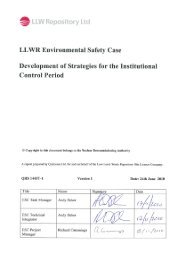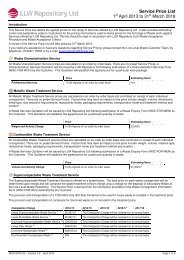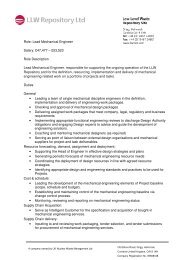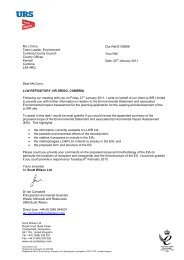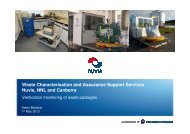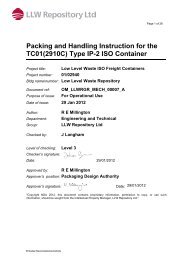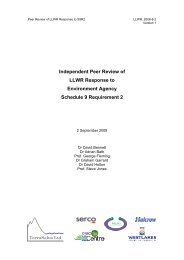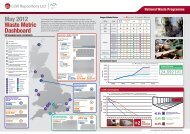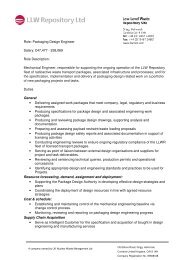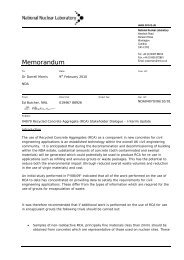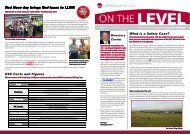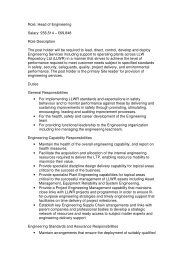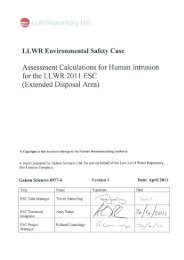Strategic Guidance on the Management of LLW and ILW / LLW ...
Strategic Guidance on the Management of LLW and ILW / LLW ...
Strategic Guidance on the Management of LLW and ILW / LLW ...
Create successful ePaper yourself
Turn your PDF publications into a flip-book with our unique Google optimized e-Paper software.
<strong>LLW</strong> Repository LtdNati<strong>on</strong>al Waste ProgrammeNWP/REP/011Issue 2.1 – Jan 2013Page 25 <strong>of</strong> 585.2.3. Surface Wiping [Ref. 5, 14, 15]Usage as st<strong>and</strong>al<strong>on</strong>e techniqueSurface c<strong>on</strong>taminated<strong>LLW</strong>AluminiumCopperMild steelMild steel (coated)Stainless steel<strong>ILW</strong>/<strong>LLW</strong>Stainless steel (coated)Volumetricallyc<strong>on</strong>taminatedActivatedDescripti<strong>on</strong> <strong>of</strong> techniqueThis manual dec<strong>on</strong>taminati<strong>on</strong> technique involves <strong>the</strong> physical removal <strong>of</strong> loose debris <strong>and</strong> dusts from <strong>the</strong>surface <strong>of</strong> <strong>the</strong> waste item through wiping or vacuuming. Wet wiping is used to remove debris or dusts whichcannot be removed by dry wiping ei<strong>the</strong>r through <strong>the</strong> use <strong>of</strong> a liquid soaked wipe or by spraying water /chemicals <strong>on</strong>to <strong>the</strong> surface <strong>of</strong> <strong>the</strong> item <strong>and</strong> wiping it <strong>of</strong>f. The applicati<strong>on</strong> <strong>of</strong> pressure during wiping <strong>of</strong>c<strong>on</strong>taminated surfaces can remove any loosely adhering c<strong>on</strong>taminati<strong>on</strong>.Outcomes Advantages Disadvantages• For <strong>LLW</strong>:o Waste metal dec<strong>on</strong>taminated toEPR out-<strong>of</strong>-scope status forunrestricted release for re-use orrecycle; oro Waste metal dec<strong>on</strong>taminated toenable fur<strong>the</strong>r processing ordisposal.• For <strong>ILW</strong> / <strong>LLW</strong> cross-boundary wastes:o Waste metal dec<strong>on</strong>taminated to<strong>LLW</strong> classificati<strong>on</strong> to enable fur<strong>the</strong>rprocessing or disposal.• Sec<strong>on</strong>dary wastes – high volume <strong>of</strong>radiologically c<strong>on</strong>taminated solid wipes /swabbing materials (potentiallyc<strong>on</strong>taminated with detergents or solvents)or solid dust / debris collected by vacuum.Technique used at:• Simple.• Applicable to widerange <strong>of</strong> metal types.• Applicable to wideactivity range.• Cannot remove fixedc<strong>on</strong>taminati<strong>on</strong>.• Not useful forvolumetricallyc<strong>on</strong>taminated oractivated metals(unless as precursorstep for <strong>on</strong>wardtransfer).• Manual method –may not bepracticable in highdose envir<strong>on</strong>ments.• Effectiveness limitedby complexgeometries orinaccessible wastes.A company owned by UK Nuclear Waste <strong>Management</strong> LtdNOT PROTECTIVELY MARKED



